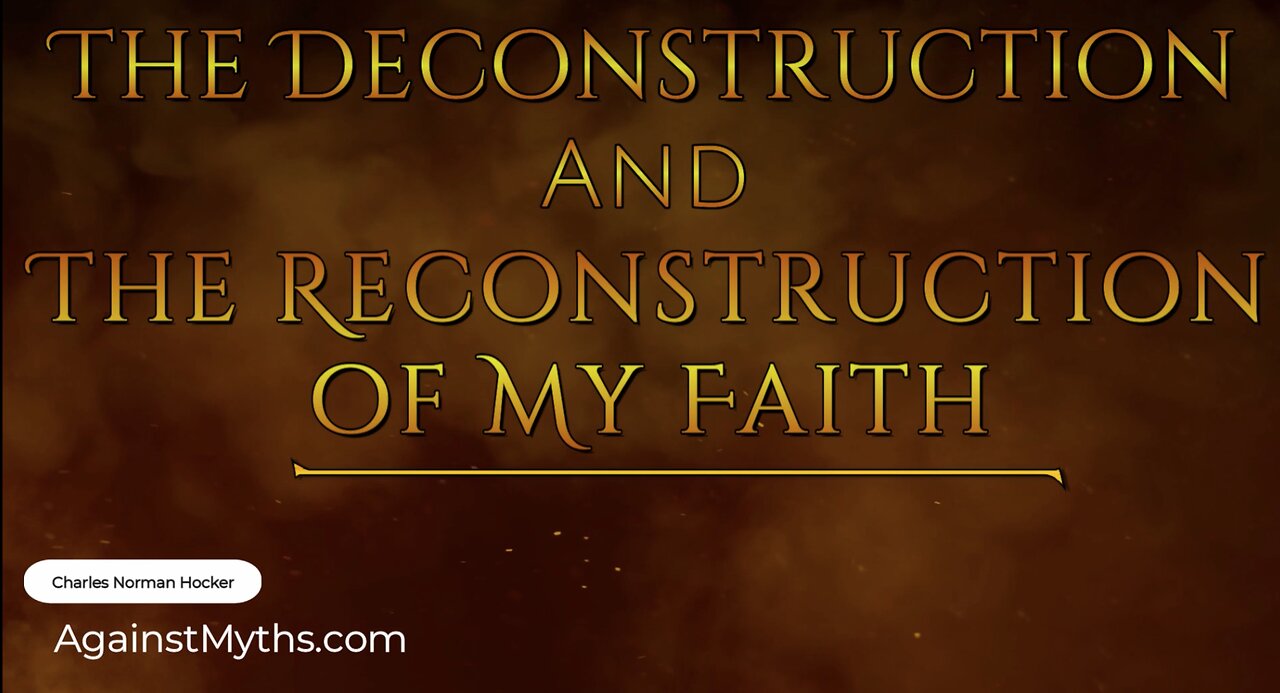Premium Only Content

The Deconstruction and The Reconstruction of My Faith, Pt. 2
Scripture:
Matthew 7:24-29
24 “Everyone then who hears these words of mine and does them will be like a wise man who built his house on the rock.
25 And the rain fell, and the floods came, and the winds blew and beat on that house, but it did not fall, because it had been founded on the rock.
26 And everyone who hears these words of mine and does not do them will be like a foolish man who built his house on the sand.
27 And the rain fell, and the floods came, and the winds blew and beat against that house, and it fell, and great was the fall of it.”
28 And when Jesus finished these sayings, the crowds were astonished at his teaching,
29 for he was teaching them as one who had authority, and not as their scribes.
The Holy Bible: English Standard Version (Wheaton, IL: Crossway Bibles, 2016), Mt 7:24–29.
There are four aspects of the faith that we can derive from this passage.
1. Christ is the cornerstone of the faith.
2. The Scripture are the revelation given to us by God, through the inspiration of the Holy Spirit, by which God reveals His plan, or the blueprint of the how He has carried out His restoration and reconciliation between Himself and His creation.
3. Theology is the foundation that takes shape from the study of the Scripture.
4. The doctrines of the faith make up the structure that is built upon that foundation.
Christ is the cornerstone of the faith.
Matthew 7:28-29 —And when Jesus finished these sayings, the crowds were astonished at his
teaching, for he was teaching them as one who had authority, and not as their scribes.
What is a cornerstone outside of Scripture? “A cornerstone is a stone that can be in the foundation, above ground level or at the summit of the roof (the “capstone”). The cornerstone of a large building gives it a reliable and firm foundation, leading to the cohesion and stability of the whole building.
Martin H. Manser, Dictionary of Bible Themes: The Accessible and Comprehensive Tool for Topical Studies (London: Martin Manser, 2009).
What is a cornerstone inside of Scripture? “In Scripture, such foundation-stones are taken as symbolic of the basis of faith in Jesus Christ and the church. Jesus Christ is thus represented as both the foundation upon which the church is built, and the capstone which crowns the whole.”
Martin H. Manser, Dictionary of Bible Themes: The Accessible and Comprehensive Tool for Topical Studies (London: Martin Manser, 2009).
Jesus shares a message to the people that show that He is the cornerstone of the faith. From the start of Matthew 5 until the end of chapter 7, Jesus is laying down the foundation of the faith through the revelation of His words. His revelation to the people implies that He is more than a carpenter. We know this by the way the people could only respond to Jesus’ authoritative teaching with astonishment.
The Scripture are the revelation given to us by God, through the inspiration of the Holy Spirit, by which God reveals His plan, or the blueprint of the how He has carried out His restoration and reconciliation between Himself and His creation.
The Scripture have alway been the Word of God. Jesus, Himself says, “Everyone, then, who hears these words of Mine (Matthew 7:24a).” His words carry power, wisdom and assurance.
The biblical writings, inspired by the Holy Spirit, have been entrusted to the church to remind it of the central teachings of the gospel, to guard it from error and to enable it to grow into holiness. The church is required to be obedient to Scripture and revere it as the Word of God.
Martin H. Manser, Dictionary of Bible Themes: The Accessible and Comprehensive Tool for Topical Studies (London: Martin Manser, 2009).
At the moment He spoke the eternal words, “Let there be light! (Genesis 1:3a),” all of creation came in to being with Jesus as the cornerstone, and His words the blueprint by which all off reality would be shaped. His words would continue to design that reality. Every divine edict He spoke from that first utterance to the end of the Book of the Revelation would effect every part of this reality and fulfill the blueprint laid out by His spoken words.
Theology is the foundation that takes shape from the study of the Scripture.
Matthew 7:24b —and does them will be like a wise man who built his house on the rock.
The study of God, as he has revealed himself in Jesus Christ and in Scripture.
Martin H. Manser, Dictionary of Bible Themes: The Accessible and Comprehensive Tool for Topical Studies (London: Martin Manser, 2009).
It is through the study of the Scripture, archeology and secular historical records that are key to understanding not only the historical Jesus, but, also, the divine God man. If one does not receive the Christian Scriptures a the divinely inspired word of God, and believe that it is inherent and infallible, then no amount of historical or archeological proof would bring them the the place of believing the truth of who Jesus is. Thus, it is essential to know and under stand that knowledge of who Jesus was, while He walked the earth, and who He is, as He sits at the right hand of the Father, is the only way to form a strong foundation.
The doctrines of the faith make up the structure that is built upon that foundation.
Matthew 7:25 —And the rain fell, and the floods came, and the winds blew and beat on that house, but it did not fall, because it had been founded on the rock.
The body of teachings of the Christian faith concerning its central beliefs. Doctrine is grounded in Scripture and aims to maintain the integrity of Christianity by distinguishing it from non-Christian beliefs. Doctrine is of central importance in Christian preaching and teaching in that it equips the people of God for effective and faithful service in his world.
Martin H. Manser, Dictionary of Bible Themes: The Accessible and Comprehensive Tool for Topical Studies (London: Martin Manser, 2009).
The teaching derived from the study of God, as revealed through the life of Christ and the Scripture make up the structure that is placed upon the foundation of our theology. It is the core beliefs that insulate, and strengthen the structure. When Jesus concludes his sermon with “and the rain fell, and the floods came, and the winds blew and beat on that house, but it did not fall, because it had been founded on the rock,” Jesus was speaking the the culmination of His spoken word and the written text that are found in the Old Testament.
When The Blueprint Is Not Followed
Matthew 7:26-27 —And everyone who hears these words of mine and does not do them will be like a foolish man who built his house on the sand. And the rain fell, and the floods came, and the winds blew and beat against that house, and it fell, and great was the fall of it.
When Scripture is read and its teachings carried out, the foundation of one’s faith is not shaken. However, when it is not received, the foundation is weak and the house, and its foundation are easily lost. A cornerstone cannot save a foundation that was askew from the start.
These are the basic points. They are based upon these passages of Scripture. They stare with Matthew 7:24-27; Luke 6:48-49; Romans 15:20; 1 Corinthians 3:10-12, 14; Ephesians 2:20; 1 Timothy 6:19; 2 Timothy 2:19-22; and Hebrews 6:1.
These passage are in line with building a foundation of faith with Christ as its cornerstone and Scripture as its framework. The only obstacle is getting the distracted masses to understand the theological and doctrinal parallels in the use of words cornerstone, blueprint, foundation and structure. Let us pray that this presentation does just that.
-
 4:56:18
4:56:18
Right Side Broadcasting Network
1 day agoLIVE REPLAY: White House Press Secretary Karoline Leavitt Holds Press Briefing - 1/31/25
259K79 -
 LIVE
LIVE
Dr Disrespect
5 hours ago🔴LIVE - DR DISRESPECT - PUBG - WHAT WINNING LOOKS LIKE
4,347 watching -

Twins Pod
16 hours agoThe Q Anon Shaman EXPOSES The Truth of J6! | Twins Pod - Episode 50 - The Q Shaman
45K6 -
 1:02:51
1:02:51
PMG
18 hours ago $0.68 earnedRFK, Immigration & DeepSeek
12.3K1 -
 LIVE
LIVE
Scammer Payback
2 hours agoCalling Scammers Live
374 watching -
 1:33:14
1:33:14
Simply Bitcoin
5 hours ago $2.69 earnedMicroStrategy PROVES You're Not BULLISH Enough On Bitcoin| EP 1172
61.2K4 -
 1:58:05
1:58:05
The Charlie Kirk Show
4 hours agoGetting Them All Confirmed + DEI in the Air | Smith, Means | 1.31.2025
140K54 -
 13:19
13:19
Misha Petrov
4 hours agoDISGUSTING! TikTok Leftists MOCK RFK Jr.’s Disorder While He EXPOSES Big Pharma
33.3K30 -
 1:01:20
1:01:20
The Dan Bongino Show
7 hours agoThe Tragic Consequences Of DEI (Ep. 2413) - 01/31/2025
779K1.3K -
 1:03:38
1:03:38
The Rubin Report
6 hours agoTulsi Gabbard Catches Her Critics Off Guard with Her Blistering Reaction to False Smears
129K116